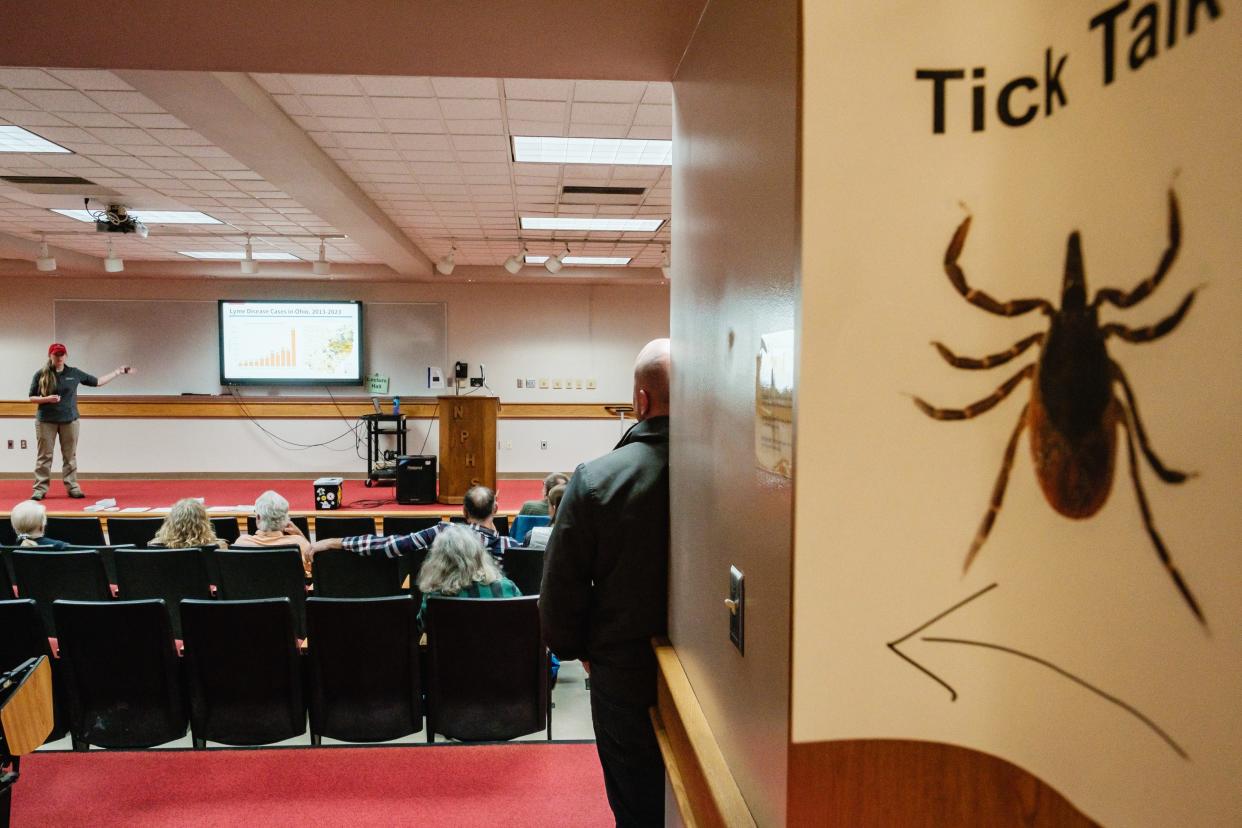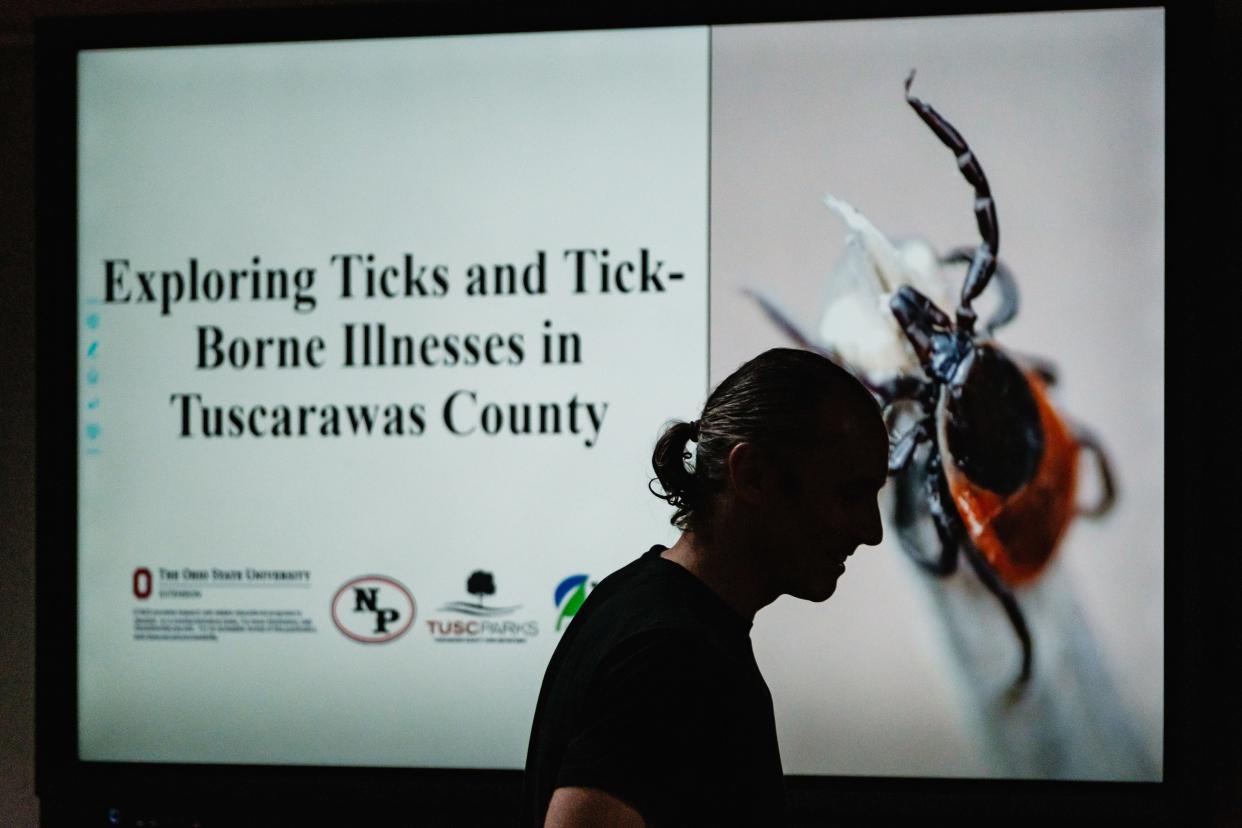Tick talk: Program focuses on tick bites and dangers of Lyme disease in our region
NEW PHILADELPHIA ‒ Ticks and the diseases they carry was the topic of a recent program at New Philadelphia High School, with experts offering tips on how to prevent being bitten by the arachnids, which are related to scorpions, spiders and mites.
A prime concern in Tuscarawas County is Lyme disease, which has been on the increase locally. It is spread by the bite of the blacklegged (or deer) tick. There were 43 confirmed cases of the disease in the county in 2023, compared to 17 in 2022, according to the Tuscarawas County Health Department.

Typical symptoms include fever, headache, fatigue and a characteristic skin rash called erythema migrans, according to the Centers for Disease Control and Prevention (CDC).
"We are at the cusp of the expanding range of several ticks," one of the speakers, Risa Pesapane of the Ohio State University College of Veterinary Medicine, told those in attendance. "This is not unique to Ohio. Nationwide, there are many species of ticks that are expanding in their distribution, and of course that is causing them to bring pathogens along with them. The changing climate also means that those ticks might be active more days of the year than they used to be."
Another project: Pesky prey: New Philadelphia students collect ticks for school project
The program was sponsored by New Philadelphia City Schools, in partnership with the Tuscarawas Parks Department and the Ohio State University Extension.
Disease-spreading ticks
The three main tick species in Ohio are the blacklegged tick, the American Dog tick and the Lone Star tick, said Leeanne Garrett, public health entomologist with the Ohio Department of Health.

The blacklegged tick is established in 61 Ohio counties, including Tuscarawas and all of its surrounding counties. The American Dog tick is native to Ohio and helps spread Rocky Mountain Spotted Fever. The Lone Star tick has been found in extreme southern Ohio. It has been associated with spreading a meat allergy in humans.
Of these pathogens, Lyme disease is most prevalent in Ohio, she said. There were 1,297 confirmed cases in Ohio in 2023.
"So, you guys are kind of right in the middle of it," Garrett said of Tuscarawas County. "This is where the (blacklegged) ticks have been the longest, since they started moving in from the east, and this is where people have been getting sick."
She recommended that people avoid tick habitats, such as wooded or brushy areas; when going into the woods, tuck in your clothes so ticks can't get to bare skins; apply repellants; when you get home, check yourself for ticks, as well as your children and pets; shower within two hours of coming in; if you find ticks on you, remove them as soon as possible with fine-tipped tweezers; and watch for signs of infection, monitoring your health for 30 days.
Family battled Lyme disease
Regina and Dave Miller, who live in a rural area north of New Philadelphia, said they have attended previous programs on ticks put on at the high school. It has special importance for them. Regina and three of their five children have contracted Lyme disease from tick bites.

The children have gotten better through the use of antibiotics and have had no longer-term effects. "It's been a little more complicated for me," Regina Miller said. She is about 85% better from Lyme disease.
They have done tick prevention on their property, including mowing and cleaning out fence rows and brush. They are also making sure their dogs and cats are treated to prevent ticks. "It's gotten a lot better since we started keeping the cats and dogs all treated," Regina said.
Studying ticks in Tuscarawas County
Students of New Philadelphia High School science teacher Kip Brady are working on a project to determine how many ticks in Tuscarawas County carry the pathogen that causes Lyme disease. They have been working on this for the past several years, collecting the insects in the field and then extracting DNA from them to see if they carry the pathogen.
Brady's students were on hand to discuss their work with those attending the program. One of them was senior Allie Wallick.
"We're talking about our apparel and what we wear in the field," she said. "So usually what we wear are white coveralls, and the reasoning that we wear these is since they're white, we can easily spot the ticks. Then we'll also wear either boots or higher shoes that cover our legs and long socks that we can tuck the pants into because ticks climb up. So, by covering more skin, it takes longer for them to get to open skin and we can find them beforehand.
"Then, we are also telling people how they can stay safe. If you're going hiking or hunting, again wearing the longer pants and keeping that tucked into longer socks and wearing lighter colors, so you can see the ticks, since they're smaller. We also treat our coveralls with permethrin. This is an insect repellant."
She got involved with Brady's research project last year. "I really enjoy it, especially with going to college soon. I'm looking into a medical field, and so getting that field experience, too, and testing in the lab, it's been really helpful for me," Wallick said.
Preventing Lyme disease
Brady said the thing that makes his project meaningful is if he and his students can change people's behavior, so they don't get sick.

"It's important to reach out to the community and connect with community and share what we're learning, and help people understand how they can stay safe and avoid getting tick bites. The big thing is to prevent Lyme disease infection," he said.
Reach Jon at 330-364-8415 or at jon.baker@timesreporter.com.
This article originally appeared on The Times-Reporter: New Philadelphia program focuses on tick bites, threat of Lyme disease
